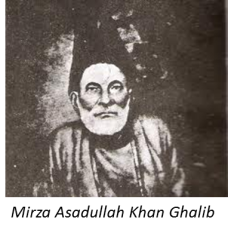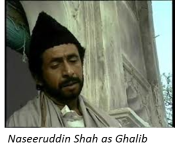 In this enthralling ghazal by the famous Persian and Urdu poet, Mirza Ghalib, he poetically and metaphorically asks the eternal, fundamental questions of life. These couplets do not denote any inquisition, but astonishment instead, for the wonderful things existing in this world. This famous Ghazal is a fine example of Ghalib’s acumen of crafting poetic expressions of realities around.
In this enthralling ghazal by the famous Persian and Urdu poet, Mirza Ghalib, he poetically and metaphorically asks the eternal, fundamental questions of life. These couplets do not denote any inquisition, but astonishment instead, for the wonderful things existing in this world. This famous Ghazal is a fine example of Ghalib’s acumen of crafting poetic expressions of realities around.
Sabz-o-gul kahaan se aaye hai (Where did this nature come from?), Abr kyaa chiz hai, havaa kyaa hai (What is this cloud and the wind?). Read on and take a moment to delve upon the meaning of each couplet.
Dil-e-naadaan tujhe huaa kya hai ?
Aakhir is dard kee dawa kya hai
O innocent heart, what happened to you
What is the cure for this pain, after all?
Hamko unse wafa ki hai ummeed
Jo naheen jaante wafa kya hai
I hope for faith from one
Who doesn’t know what it means to be faithful
Ham hain mushtaaq aur woh bezaar
Ya ilaahee ! Yeh maajra kya hai ?
I am anxious and eager, he is cold and displeased
Oh God, what is this mystery?
Main bhi muh me zabaan rakhataa hun
Kaash puchho ki mudda kyaa hai
I too have a tongue in my mouth (I too have an opinion)
If only I was I asked my intention (mudda’ is a distorted form of the actual Urdu word ‘mudua’ which means ‘ intention’, ‘will’ or ‘objective’)
Jab ki tujh bin naheen koyi maujood
Fir ye hangaama, ‘ei khuda ! Kya hai
If there is no one except you in my world
Then why this ruckus, what is this world, O God?
Ye pari chehra log kaise hain
Gamaza-o-ishwa-o-ada kya hai
What are these beautiful angelic-faced women like?
What are all the airs and graces about? (their amorous glances, their coquettishness and their enticing style)
Ghamza : an amorous glance or wink; Ishwa: Coquetry (naaz/ nakhray); Ada: an enticing style or a tempting gesture (generally by women)
Shikan-e-zulf-e-ambari kyon hai
Nigah-e-chashm-e-surma sa kya hai
Why do these fragrant curls exist? (referring to a woman’s tresses)
What is the meaning of the glance of your eyes lined with kohl?
Sabz-o-gul kahaan se aaye hai
Abr kyaa chiz hai, havaa kyaa hai
Where has this beautiful greenery and nature come from?
What is this cloud and the wind?
Jaan tum par nisaar karta hoon
Main naheen jaanata duaa kya hai
I am willing to sacrifice my life for you
I do not know what else is prayer?
Haan bhalaa kar, teraa bhalaa hogaa
Aur daravesh ki sadaa kyaa hai
Yes, do good, and good will come to you
What, but this does the dervish say?
Maine maanaa ki kuchh nahi “Ghalib”
Muft haath aaye, to buraa kyaa hai
I agree that ‘Ghalib’ is ‘nothing’,
But what harm does it do, if you get him for ‘nothing’?
 Here is part of the ghazal as depicted in the 1954 film, Mirza Ghalib, directed by Sohrab Modi, which portrays the trials, tribulations, triumphs, and utlimate descent to poverty of Mirza Ghalib and his tragic and ill-fated love with a beautiful courtesan named Chaudvin. Bharat Bhushan played the role of Ghalib. The Urdu short story writer, Saadat Hasan Manto is credited with the storyline for the movie.
Here is part of the ghazal as depicted in the 1954 film, Mirza Ghalib, directed by Sohrab Modi, which portrays the trials, tribulations, triumphs, and utlimate descent to poverty of Mirza Ghalib and his tragic and ill-fated love with a beautiful courtesan named Chaudvin. Bharat Bhushan played the role of Ghalib. The Urdu short story writer, Saadat Hasan Manto is credited with the storyline for the movie.
 Below is the same song as sung, in a very different tempo and style, by Chitra Singh for the 1988 TV show of the same name. Naseeruddin Shah essayed the role of Ghalib and is the face of the poet for many in today’s generation!
Below is the same song as sung, in a very different tempo and style, by Chitra Singh for the 1988 TV show of the same name. Naseeruddin Shah essayed the role of Ghalib and is the face of the poet for many in today’s generation!
(Thanks to Shakeel Warsi for his inputs to this post)

hello, how are u? I hope u’re fine =)
i’m Anderson, I’m from Brazil. I need to do a seminar about ghazal, ur translation will help me a lot, but i’d like to know if u could tell the the meaning of “kyaa hai” (‘Radif’) and the rhyming words before it (‘Kaafiyaa’), like maajra, wafa etc? I know u already did a translation, but i will need to do a analysis about rhyming, so if u could help me, would be great. But if i can’t, doesn’t matter, because ur translation already will help me a lot . Thanks!
Hello Anderson – thank you for your interest in this beautiful language. It truly is very encouraging.
Let us try and see if we can address your queries. The literal translation of ‘Kya hai’ means ‘what is’ as a question. Hence, Ghalib is ending each couplet as an unanswered question, mostly rhetoric. When the last word in every couplet is the same or is rhyming, it refers to qafiya. Each couplet in a ghazal, in addition to having qafiya, can also have radif, which is rhyming of more than the last two or three words. The meanings of the lafz in qafiya – Maajra means mystery, Wafa means loyalty (a wafadaar person is one who is loyal), Muddua is intentions or opnions, Khuda means God, Ada is style or charm, Nigah-e-chashm-e-surma (nigah – glance, chasme – eye, surma – kohl or black eye liner) used by Ghalib to describe his beloved’s beauty, havaa is wind and dua is prayer. buraa is something bad or hamrful, sadaa refers to preachings or utterances of someone.
Hope this helps in your analysis. All the best!
Thank you so much for your help, thank you.Could you tell me your name and your nationality to I put in the greetings of the seminar? If you don’t want to do this, there’s no problem, I put the credits with the blog’s name. Or if you can do this, but you prefer to use another ways, could u sent this details to my e-mail? It’s hamlet1614@hotmail.com.
Thank you, have a nice weed end =)
i have never been so blown away as by this ghazal by Mirza Galib.
this is the first one i have read and i’m certainly looking forward to read others by him.
and special thanks to all people concerned who took time and work to put the meanings of this ghazal together.
very good work. :)
There is no audio
Hi – thanks for your post. We have checked the link and the audio is working. Pls check again at your end. Here is the link for your reference – http://www.youtube.com/watch?v=iMiRW8BPBFg
can you please add its full explanation here…i mean “tashreeh” in urdu…i need it…
Pingback: DAD’S STORY: GHALIB | iqbal1066
Pingback: Ghalib se poocho | Shrimati 420
Just wondering, shouldn’t the ninth couplet read;
Jaan tum per nisaar karta hun
Main nahin janta WAFA kaya hai
Hello Shakeel – the last line is “Main nahin jaanta DUAA kya hai” as also sung by the late Jagjit Singh and Chitra Singh here – https://www.youtube.com/watch?v=Ys7t9Tsf9s8
Iraday jinke pokhta ho,nizar jinke khuda pe ho wo talatum khaiz mojju se nahi dartay…
Simply mesmerizing !!
Thank you urduwallahs, It’s a very useful blog. Though I can’t read Urdu in Arabic script I have a dictionary (Lughat) of Urdu to Hindi but some words are just not there and I feel at a loss sometimes and miss the real ‘mazaa’.Dr. K. M. Ojha
Pingback: Mehfil at Prithvi: Celebrating Urdu Poetry – Yuktie Jhangiani
Pingback: Dil-e-Nadan Tujhe Hua Kya Hai | सिफ़र.
Pingback: Mehfil at Prithvi: Celebrating Urdu Poetry – Yuktiesays